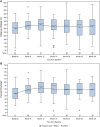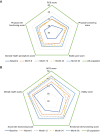Effectiveness of asfotase alfa for treatment of adults with hypophosphatasia: results from a global registry
- PMID: 38459585
- PMCID: PMC10921796
- DOI: 10.1186/s13023-024-03048-6
Effectiveness of asfotase alfa for treatment of adults with hypophosphatasia: results from a global registry
Abstract
Background: Hypophosphatasia (HPP) is a rare inherited disease caused by deficient activity of tissue-nonspecific alkaline phosphatase. Many adults with HPP have a high burden of disease, experiencing chronic pain, fatigue, limited mobility, and dental issues, contributing to decreased health-related quality of life (HRQoL). HPP may be treated with the enzyme replacement therapy asfotase alfa though real-world data in adults are limited. This analysis was conducted to assess the clinical effectiveness of asfotase alfa among adults in the Global HPP Registry.
Methods: The Global HPP Registry is an observational, prospective, multinational study. Adults ≥ 18 years of age were included in this analysis if they had serum alkaline phosphatase (ALP) activity below the age- and sex-adjusted reference ranges, and/or ALPL variant(s), and received asfotase alfa for ≥ 6 months. Mobility was assessed with the 6-Minute Walk Test (6MWT), and patient-reported outcomes tools were used to assess pain (Brief Pain Inventory-Short Form), quality of life (36-item Short Form Health Survey, version 2 [SF-36v2]), and disability (Health Assessment Questionnaire-Disability Index) at multiple time points from baseline through Month 36. Data were collected as per usual standard of care; patients may not have contributed data at all time points.
Results: A total of 190 patients met the inclusion criteria. For patients with ≥ 1 follow-up measurement, the mean distance achieved on 6MWT increased from 404 m (range 60-632 m) at baseline (n = 31) to 484 m at Month 12 (range 240-739 m; n = 18) and remained above baseline through Month 36 (n = 7). Improvements in mean self-reported pain severity scores ranged from - 0.72 (95% CI: - 1.23, - 0.21; n = 38) to - 1.13 (95% CI: - 1.76, - 0.51; n = 26) and were observed at all time points. Improvements in the Physical Component Summary score of SF-36v2 were achieved by Month 6 and sustained throughout follow-up. There was a trend toward improvement in the Mental Component Summary score of SF-36v2 at most time points, with considerable fluctuations from Months 12 (n = 28) through 36 (n = 21). The most frequent adverse events were injection site reactions.
Conclusions: Adults with HPP who received asfotase alfa for ≥ 6 months experienced improvements in mobility, physical function, and HRQoL, which were maintained over 3 years of follow-up.
Registration: NCT02306720; EUPAS13514.
© 2024. The Author(s).
Conflict of interest statement
PSK, KMD, GAMM, AL, CRG, KO, WH, and LS consult for/have received research funding/honoraria from Alexion, AstraZeneca Rare Disease. AP, AM, and SF are employees of and may own stock/options in Alexion, AstraZeneca Rare Disease. The authors declare that the research was conducted in the absence of any commercial or financial relationships that could be construed as a potential conflict of interest.
Figures





References
-
- Rockman-Greenberg C. Hypophosphatasia. Pediatr Endocrinol Rev. 2013;10(2):380–388. - PubMed
MeSH terms
Substances
Associated data
LinkOut - more resources
Full Text Sources
Medical
Miscellaneous

